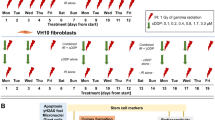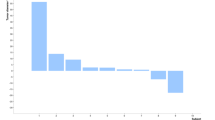Abstract
We report that radiation enhances the antitumor efficacy of the oncolytic adenovirus vector VRX-007 in Syrian hamster tumors. We used tumor-specific irradiation of subcutaneous tumors and compared treatment options of radiation alone or combined with VRX-007 and cyclophosphamide (CP). Radiation therapy further augmented the VRX-007-mediated inhibition of tumor growth, in both CP-treated and non-CP-treated hamsters, even though radiation did not lead to increased viral replication in tumors when compared with those treated with VRX-007 alone. Moreover, tumor growth inhibition was similar in tumors irradiated either 1 week before or after injection with VRX-007, which suggests that radiation exerts its antitumor effect independently from vector therapy. Thus, our results demonstrate that these two therapies do not have to be provided simultaneously to enhance their combined effectiveness against subcutaneous hamster tumors.
This is a preview of subscription content, access via your institution
Access options
Subscribe to this journal
Receive 12 print issues and online access
$259.00 per year
only $21.58 per issue
Buy this article
- Purchase on Springer Link
- Instant access to full article PDF
Prices may be subject to local taxes which are calculated during checkout





Similar content being viewed by others
References
Toth K, Wold WS . Increasing the efficacy of oncolytic adenovirus vectors. Viruses 2010; 2: 1844–1866.
Yamamoto M, Curiel DT . Current issues and future directions of oncolytic adenoviruses. Mol Ther 2010; 18: 243–250.
Pesonen S, Kangasniemi L, Hemminki A . Oncolytic adenoviruses for the treatment of human cancer: focus on translational and clinical data. Mol Pharm 2011; 8: 12–28.
Liu TC, Galanis E, Kirn D . Clinical trial results with oncolytic virotherapy: a century of promise, a decade of progress. Nat Clin Pract Oncol 2007; 4: 101–117.
Yu W, Fang H . Clinical trials with oncolytic adenovirus in China. Current Cancer Drug Targets 2007; 7: 141–148.
Ottolino-Perry K, Diallo JS, Lichty BD, Bell JC, McCart JA . Intelligent design: combination therapy with oncolytic viruses. Mol Ther 2010; 18: 251–263.
Doronin K, Toth K, Kuppuswamy M, Ward P, Tollefson AE, Wold WSM . Tumor-specific, replication-competent adenovirus vectors overexpressing the Adenovirus Death Protein. J Virol 2000; 74: 6147–6155.
Doronin K, Toth K, Kuppuswamy M, Krajcsi P, Tollefson AE, Wold WSM . Overexpression of the ADP (E3-11.6K) protein increases cell lysis and spread of adenovirus. Virology 2003; 305: 378–387.
Tollefson AE, Scaria A, Hermiston TW, Ryerse JS, Wold LJ, Wold WSM . The adenovirus death protein (E3-11.6K) is required at very late stages of infection for efficient cell lysis and release of adenovirus from infected cells. J Virol 1996; 70: 2296–2306.
Doronin K, Kuppuswamy M, Toth K, Tollefson AE, Krajcsi P, Krougliak V et al. Tissue-specific, tumor-selective, replication-competent adenovirus vector for cancer gene therapy. J Virol 2001; 75: 3314–3324.
Toth K, Kuppuswamy M, Shashkova EV, Spencer JF, Wold WSM . A fully replication-competent adenovirus vector with enhanced oncolytic properties. Cancer Gene Ther 2010; 17: 761–770.
Toth K, Spencer JF, Tollefson AE, Kuppuswamy M, Doronin K, Lichtenstein DL et al. Cotton rat tumor model for the evaluation of oncolytic adenoviruses. Hum Gene Ther 2005; 16: 139–146.
Thomas MA, Spencer JF, Toth K, Sagartz JE, Phillips N, Wold WSM . Immunosuppression enhances oncolytic adenovirus replication and anti tumor efficacy in the Syrian hamster model. Mol Ther 2008; 16: 1665–1673.
Dhar D, Spencer JF, Toth K, Wold WSM . Effect of preexisting immunity on oncolytic adenovirus vector INGN 007 antitumor efficacy in immunocompetent and immunosuppressed Syrian hamsters. J Virol 2009; 83: 2130–2139.
Spencer JF, Sagartz JE, Wold WSM, Toth K . New pancreatic carcinoma model for studying oncolytic adenoviruses in the permissive Syrian hamster. Cancer Gene Ther 2009; 16: 912–922.
Sonabend AM, Ulasov IV, Han Y, Rolle CE, Nandi S, Cao D et al. Biodistribution of an oncolytic adenovirus after intracranial injection in permissive animals: a comparative study of Syrian hamsters and cotton rats. Cancer Gene Ther 2009; 16: 362–372.
Thomas MA, Spencer JF, La Regina MC, Dhar D, Tollefson AE, Toth K et al. Syrian hamster as a permissive immunocompetent animal model for the study of oncolytic adenovirus vectors. Cancer Res 2006; 66: 1270–1276.
Bortolanza S, Bunuales M, Otano I, Gonzalez-Aseguinolaza G, Ortiz-de-Solorzano C, Perez D et al. Treatment of pancreatic cancer with an oncolytic adenovirus expressing interleukin-12 in Syrian hamsters. Mol Ther 2009; 17: 614–622.
Rogulski KR, Freytag SO, Zhang K, Gilbert JD, Paielli DL, Kim JH et al. In vivo antitumor activity of ONYX-015 is influenced by p53 status and is augmented by radiotherapy. Cancer Res 2000; 60: 1193–1196.
Wold WSM, Ison MG . Adenoviruses. In: Knipe DM, Howley PM, (eds) Fields Virology 6 edn vol. 1. Lippincott Williams & Wilkins: Philadelphia pp 1732–1767 2013.
Thomas O, Mahe MA, Campion L, Bourdin S, Milpied N, Brunet G et al. Long-term complications of total body irradiation in adults. Int J Radiat Oncol Biol Phys 2001; 49: 152–131.
Toth K, Tarakanova V, Doronin K, Ward P, Kuppuswamy M, Locke JL et al. Radiation increases the activity of oncolytic adenovirus cancer gene therapy vectors that overexpress the ADP (E3-11.6K) protein. Cancer Gene Ther 2003; 10: 193–200.
Thomas MA, Spencer JF, Wold WSM . Use of the Syrian hamster as an animal model for oncolytic adenovirus vectors. In: Tollefson AE, Wold WSM, (eds). Methods in Molecular Medicine. vol 1. 2nd edn Humana Press: Totowa pp 169–183 2007.
Lichtenstein DL, Toth K, Doronin K, Tollefson AE, Wold WSM . Functions and mechanisms of action of the adenovirus E3 proteins. Int Rev Immunol 2004; 23: 75–111.
Aste-Amezaga M, Bett AJ, Wang F, Casimiro DR, Antonello JM, Patel DK et al. Quantitative adenovirus neutralization assays based on the secreted alkaline phosphatase reporter gene: application in epidemiologic studies and in the design of adenovector vaccines. HumGene Ther 2004; 15: 293–304.
Jemal A, Siegel R, Ward E, Murray T, Xu JQ, Thun MJ . Cancer statistics, 2007. CA Cancer J Clin 2007; 57: 43–66.
Tysome J, Li X, Wang S, Wang P, Gao D, Du P et al. A novel therapeutic regimen to eradicate established solid tumors with an effective induction of tumor-specific immunity. Clin Cancer Res 2012; 18: 6679–6689.
Hu W, Davis JJ, Zhu H, Dong F, Guo W, Ang J et al. Redirecting adaptive immunity against foreign antigens to tumors for cancer therapy. Cancer Biol Ther 2007; 6: 1773–1779.
Dhar D, Spencer JF, Toth K, Wold WSM . Pre-existing immunity and passive immunity to adenovirus 5 prevents toxicity caused by an oncolytic adenovirus vector in the Syrian hamster model. Mol Ther 2009; 17: 1724–1732.
Begg AC, Stewart FA, Vens C . Strategies to improve radiotherapy with targeted drugs. Nat Rev Cancer 2011; 11: 239–253.
Chu RL, Post DE, Khuri FR, Van Meir EG . Use of replicating oncolytic adenoviruses in combination therapy for cancer. Clin Cancer Res 2004; 10: 5299–5312.
Rajecki M, Hallstrom T, Hakkarainen T, Nokisalmi P, Hautaniemi S, Nieminen AI et al. Mre11 inhibition by oncolytic adenovirus associates with autophagy and underlies synergy with ionizing radiation. Int J Cancer 2009; 125: 2441–2449.
Huh JJ, Wolf JK, Fightmaster DL, Lotan R, Follen M . Transduction of adenovirus-mediated wild-type p53 after radiotherapy in human cervical cancer cells. Gynecol Oncol 2003; 89: 243–250.
Kuroda S, Fujiwara T, Shirakawa Y, Yamasaki Y, Yano S, Uno F et al. Telomerase-dependent oncolytic adenovirus sensitizes human cancer cells to ionizing radiation via inhibition of DNA repair machinery. Cancer Res 2010; 70: 9339–9348.
Dai MH, Zamarin D, Gao SP, Chou TC, Gonzalez L, Lin SF et al. Synergistic action of oncolytic herpes simplex virus and radiotherapy in pancreatic cancer cell lines. Br J Surg 2010; 97: 1385–1394.
Gallardo D, Drazan KE, McBride WH . Adenovirus-based transfer of wild-type p53 gene increases ovarian tumor radiosensitivity. Cancer Res 1996; 56: 4891–4893.
Spitz FR, Nguyen D, Skibber JM, Meyn RE, Cristiano RJ, Roth JA . Adenoviral-mediated wild-type p53 gene expression sensitizes colorectal cancer cells to ionizing radiation. Clin Cancer Res 1996; 2: 1665–1671.
Liu C, Zhang Y, Liu MM, Zhou H, Chowdhury WH, Lupold SE et al. Evaluation of continuous low dose rate versus acute single high dose rate radiation combined with oncolytic viral therapy for prostate cancer. Int J Radiat Biol Relat Stud Phys Chem Med 2010; 86: 220–229.
Nandi S, Ulasov IV, Tyler MA, Sugihara AQ, Molinero L, Han Y et al. Low-dose radiation enhances survivin-mediated virotherapy against malignant glioma stem cells. Cancer Res 2008; 68: 5778–5784.
Advani SJ, Sibley GS, Song PY, Hallahan DE, Kataoka Y, Roizman B et al. Enhancement of replication of genetically engineered herpes simplex viruses by ionizing radiation: a new paradigm for destruction of therapeutically intractable tumors. Gene Ther 1998; 5: 160–165.
Lamfers ML, Grill J, Dirven CM, Van Beusechem VW, Geoerger B, Van Den BJ et al. Potential of the conditionally replicative adenovirus Ad5-Delta24RGD in the treatment of malignant gliomas and its enhanced effect with radiotherapy. Cancer Res 2002; 62: 5736–5742.
Wein LM, Wu JT, Kirn DH . Validation and analysis of a mathematical model of a replication-competent oncolytic virus for cancer treatment: implications for virus design and delivery. Cancer Res 2003; 63: 1317–1324.
Kim J, Kim PH, Yoo JY, Yoon AR, Choi HJ, Seong J et al. Double E1B 19kDa- and E1B 55kDa-deleted oncolytic adenovirus in combination with radiotherapy elicits an enhanced anti-tumor effect. Gene Ther 2009; 16: 1111–1121.
Kurozumi K, Hardcastle J, Thakur R, Yang M, Christoforidis G, Fulci G et al. Effect of tumor microenvironment modulation on the efficacy of oncolytic virus therapy. J Natl Cancer Inst 2007; 99: 1768–1781.
Acknowledgements
We thank A Tollefson for her helpful discussions. This work was supported by grant CA118022 from the National Institutes of Health.
Author information
Authors and Affiliations
Corresponding author
Ethics declarations
Competing interests
The VRX-007 vector was provided by VirRx, and WSMW and KT own stock in the company.
Additional information
Supplementary Information accompanies the paper on Cancer Gene Therapy website
Supplementary information
Rights and permissions
About this article
Cite this article
Young, B., Spencer, J., Ying, B. et al. The effects of radiation on antitumor efficacy of an oncolytic adenovirus vector in the Syrian hamster model. Cancer Gene Ther 20, 531–537 (2013). https://doi.org/10.1038/cgt.2013.50
Received:
Accepted:
Published:
Issue Date:
DOI: https://doi.org/10.1038/cgt.2013.50



